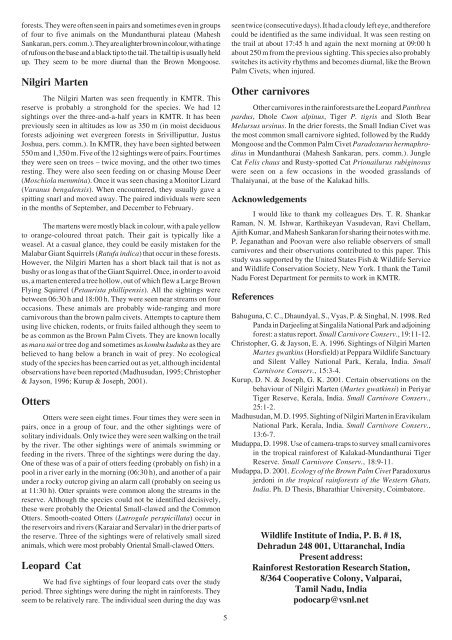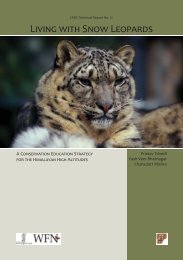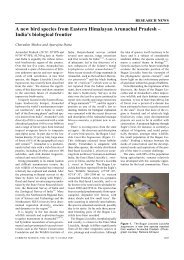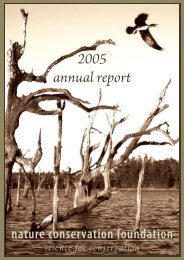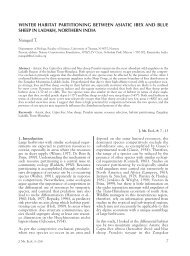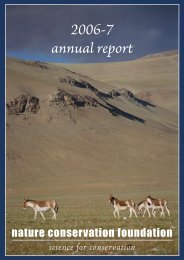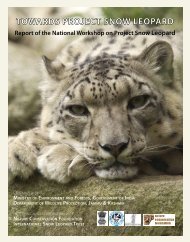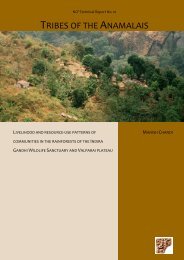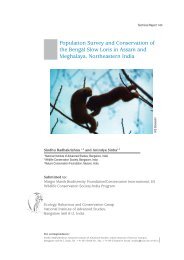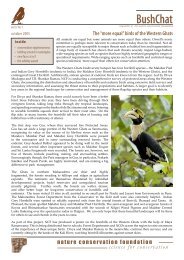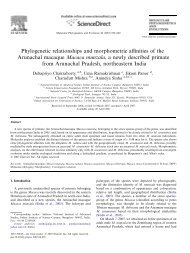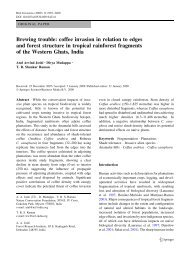Observations of small carnivores in the Kalakad-Mundanthurai Tiger ...
Observations of small carnivores in the Kalakad-Mundanthurai Tiger ...
Observations of small carnivores in the Kalakad-Mundanthurai Tiger ...
You also want an ePaper? Increase the reach of your titles
YUMPU automatically turns print PDFs into web optimized ePapers that Google loves.
forests. They were <strong>of</strong>ten seen <strong>in</strong> pairs and sometimes even <strong>in</strong> groups<br />
<strong>of</strong> four to five animals on <strong>the</strong> <strong>Mundanthurai</strong> plateau (Mahesh<br />
Sankaran, pers. comm.). They are a lighter brown <strong>in</strong> colour, with a t<strong>in</strong>ge<br />
<strong>of</strong> rufous on <strong>the</strong> base and a black tip to <strong>the</strong> tail. The tail tip is usually held<br />
up. They seem to be more diurnal than <strong>the</strong> Brown Mongoose.<br />
Nilgiri Marten<br />
The Nilgiri Marten was seen frequently <strong>in</strong> KMTR. This<br />
reserve is probably a stronghold for <strong>the</strong> species. We had 12<br />
sight<strong>in</strong>gs over <strong>the</strong> three-and-a-half years <strong>in</strong> KMTR. It has been<br />
previously seen <strong>in</strong> altitudes as low as 350 m (<strong>in</strong> moist deciduous<br />
forests adjo<strong>in</strong><strong>in</strong>g wet evergreen forests <strong>in</strong> Srivilliputtur, Justus<br />
Joshua, pers. comm.). In KMTR, <strong>the</strong>y have been sighted between<br />
550 m and 1,350 m. Five <strong>of</strong> <strong>the</strong> 12 sight<strong>in</strong>gs were <strong>of</strong> pairs. Four times<br />
<strong>the</strong>y were seen on trees – twice mov<strong>in</strong>g, and <strong>the</strong> o<strong>the</strong>r two times<br />
rest<strong>in</strong>g. They were also seen feed<strong>in</strong>g on or chas<strong>in</strong>g Mouse Deer<br />
(Moschiola memm<strong>in</strong>a). Once it was seen chas<strong>in</strong>g a Monitor Lizard<br />
(Varanus bengalensis). When encountered, <strong>the</strong>y usually gave a<br />
spitt<strong>in</strong>g snarl and moved away. The paired <strong>in</strong>dividuals were seen<br />
<strong>in</strong> <strong>the</strong> months <strong>of</strong> September, and December to February.<br />
The martens were mostly black <strong>in</strong> colour, with a pale yellow<br />
to orange-coloured throat patch. Their gait is typically like a<br />
weasel. At a casual glance, <strong>the</strong>y could be easily mistaken for <strong>the</strong><br />
Malabar Giant Squirrels (Ratufa <strong>in</strong>dica) that occur <strong>in</strong> <strong>the</strong>se forests.<br />
However, <strong>the</strong> Nilgiri Marten has a short black tail that is not as<br />
bushy or as long as that <strong>of</strong> <strong>the</strong> Giant Squirrel. Once, <strong>in</strong> order to avoid<br />
us, a marten entered a tree hollow, out <strong>of</strong> which flew a Large Brown<br />
Fly<strong>in</strong>g Squirrel (Petaurista phillipensis). All <strong>the</strong> sight<strong>in</strong>gs were<br />
between 06:30 h and 18:00 h. They were seen near streams on four<br />
occasions. These animals are probably wide-rang<strong>in</strong>g and more<br />
carnivorous than <strong>the</strong> brown palm civets. Attempts to capture <strong>the</strong>m<br />
us<strong>in</strong>g live chicken, rodents, or fruits failed although <strong>the</strong>y seem to<br />
be as common as <strong>the</strong> Brown Palm Civets. They are known locally<br />
as mara nai or tree dog and sometimes as kombu kuduka as <strong>the</strong>y are<br />
believed to hang below a branch <strong>in</strong> wait <strong>of</strong> prey. No ecological<br />
study <strong>of</strong> <strong>the</strong> species has been carried out as yet, although <strong>in</strong>cidental<br />
observations have been reported (Madhusudan, 1995; Christopher<br />
& Jayson, 1996; Kurup & Joseph, 2001).<br />
Otters<br />
Otters were seen eight times. Four times <strong>the</strong>y were seen <strong>in</strong><br />
pairs, once <strong>in</strong> a group <strong>of</strong> four, and <strong>the</strong> o<strong>the</strong>r sight<strong>in</strong>gs were <strong>of</strong><br />
solitary <strong>in</strong>dividuals. Only twice <strong>the</strong>y were seen walk<strong>in</strong>g on <strong>the</strong> trail<br />
by <strong>the</strong> river. The o<strong>the</strong>r sight<strong>in</strong>gs were <strong>of</strong> animals swimm<strong>in</strong>g or<br />
feed<strong>in</strong>g <strong>in</strong> <strong>the</strong> rivers. Three <strong>of</strong> <strong>the</strong> sight<strong>in</strong>gs were dur<strong>in</strong>g <strong>the</strong> day.<br />
One <strong>of</strong> <strong>the</strong>se was <strong>of</strong> a pair <strong>of</strong> otters feed<strong>in</strong>g (probably on fish) <strong>in</strong> a<br />
pool <strong>in</strong> a river early <strong>in</strong> <strong>the</strong> morn<strong>in</strong>g (06:30 h), and ano<strong>the</strong>r <strong>of</strong> a pair<br />
under a rocky outcrop giv<strong>in</strong>g an alarm call (probably on see<strong>in</strong>g us<br />
at 11:30 h). Otter spra<strong>in</strong>ts were common along <strong>the</strong> streams <strong>in</strong> <strong>the</strong><br />
reserve. Although <strong>the</strong> species could not be identified decisively,<br />
<strong>the</strong>se were probably <strong>the</strong> Oriental Small-clawed and <strong>the</strong> Common<br />
Otters. Smooth-coated Otters (Lutrogale perspicillata) occur <strong>in</strong><br />
<strong>the</strong> reservoirs and rivers (Karaiar and Servalar) <strong>in</strong> <strong>the</strong> drier parts <strong>of</strong><br />
<strong>the</strong> reserve. Three <strong>of</strong> <strong>the</strong> sight<strong>in</strong>gs were <strong>of</strong> relatively <strong>small</strong> sized<br />
animals, which were most probably Oriental Small-clawed Otters.<br />
Leopard Cat<br />
We had five sight<strong>in</strong>gs <strong>of</strong> four leopard cats over <strong>the</strong> study<br />
period. Three sight<strong>in</strong>gs were dur<strong>in</strong>g <strong>the</strong> night <strong>in</strong> ra<strong>in</strong>forests. They<br />
seem to be relatively rare. The <strong>in</strong>dividual seen dur<strong>in</strong>g <strong>the</strong> day was<br />
seen twice (consecutive days). It had a cloudy left eye, and <strong>the</strong>refore<br />
could be identified as <strong>the</strong> same <strong>in</strong>dividual. It was seen rest<strong>in</strong>g on<br />
<strong>the</strong> trail at about 17:45 h and aga<strong>in</strong> <strong>the</strong> next morn<strong>in</strong>g at 09:00 h<br />
about 250 m from <strong>the</strong> previous sight<strong>in</strong>g. This species also probably<br />
switches its activity rhythms and becomes diurnal, like <strong>the</strong> Brown<br />
Palm Civets, when <strong>in</strong>jured.<br />
O<strong>the</strong>r <strong>carnivores</strong><br />
O<strong>the</strong>r <strong>carnivores</strong> <strong>in</strong> <strong>the</strong> ra<strong>in</strong>forests are <strong>the</strong> Leopard Panthrea<br />
pardus, Dhole Cuon alp<strong>in</strong>us, <strong>Tiger</strong> P. tigris and Sloth Bear<br />
Melursus urs<strong>in</strong>us. In <strong>the</strong> drier forests, <strong>the</strong> Small Indian Civet was<br />
<strong>the</strong> most common <strong>small</strong> carnivore sighted, followed by <strong>the</strong> Ruddy<br />
Mongoose and <strong>the</strong> Common Palm Civet Paradoxurus hermaphroditus<br />
<strong>in</strong> <strong>Mundanthurai</strong> (Mahesh Sankaran, pers. comm.). Jungle<br />
Cat Felis chaus and Rusty-spotted Cat Prionailurus rubig<strong>in</strong>osus<br />
were seen on a few occasions <strong>in</strong> <strong>the</strong> wooded grasslands <strong>of</strong><br />
Thalaiyanai, at <strong>the</strong> base <strong>of</strong> <strong>the</strong> <strong>Kalakad</strong> hills.<br />
Acknowledgements<br />
I would like to thank my colleagues Drs. T. R. Shankar<br />
Raman, N. M. Ishwar, Karthikeyan Vasudevan, Ravi Chellam,<br />
Ajith Kumar, and Mahesh Sankaran for shar<strong>in</strong>g <strong>the</strong>ir notes with me.<br />
P. Jeganathan and Poovan were also reliable observers <strong>of</strong> <strong>small</strong><br />
<strong>carnivores</strong> and <strong>the</strong>ir observations contributed to this paper. This<br />
study was supported by <strong>the</strong> United States Fish & Wildlife Service<br />
and Wildlife Conservation Society, New York. I thank <strong>the</strong> Tamil<br />
Nadu Forest Department for permits to work <strong>in</strong> KMTR.<br />
References<br />
Bahuguna, C. C., Dhaundyal, S., Vyas, P. & S<strong>in</strong>ghal, N. 1998. Red<br />
Panda <strong>in</strong> Darjeel<strong>in</strong>g at S<strong>in</strong>galila National Park and adjo<strong>in</strong><strong>in</strong>g<br />
forest: a status report. Small Carnivore Conserv., 19:11-12.<br />
Christopher, G. & Jayson, E. A. 1996. Sight<strong>in</strong>gs <strong>of</strong> Nilgiri Marten<br />
Martes gwatk<strong>in</strong>s (Horsfield) at Peppara Wildlife Sanctuary<br />
and Silent Valley National Park, Kerala, India. Small<br />
Carnivore Conserv., 15:3-4.<br />
Kurup, D. N. & Joseph, G. K. 2001. Certa<strong>in</strong> observations on <strong>the</strong><br />
behaviour <strong>of</strong> Nilgiri Marten (Martes gwatk<strong>in</strong>si) <strong>in</strong> Periyar<br />
<strong>Tiger</strong> Reserve, Kerala, India. Small Carnivore Conserv.,<br />
25:1-2.<br />
Madhusudan, M. D. 1995. Sight<strong>in</strong>g <strong>of</strong> Nilgiri Marten <strong>in</strong> Eravikulam<br />
National Park, Kerala, India. Small Carnivore Conserv.,<br />
13:6-7.<br />
Mudappa, D. 1998. Use <strong>of</strong> camera-traps to survey <strong>small</strong> <strong>carnivores</strong><br />
<strong>in</strong> <strong>the</strong> tropical ra<strong>in</strong>forest <strong>of</strong> <strong>Kalakad</strong>-<strong>Mundanthurai</strong> <strong>Tiger</strong><br />
Reserve. Small Carnivore Conserv., 18:9-11.<br />
Mudappa, D. 2001. Ecology <strong>of</strong> <strong>the</strong> Brown Palm Civet Paradoxurus<br />
jerdoni <strong>in</strong> <strong>the</strong> tropical ra<strong>in</strong>forests <strong>of</strong> <strong>the</strong> Western Ghats,<br />
India. Ph. D Thesis, Bharathiar University, Coimbatore.<br />
Wildlife Institute <strong>of</strong> India, P. B. # 18,<br />
Dehradun 248 001, Uttaranchal, India<br />
Present address:<br />
Ra<strong>in</strong>forest Restoration Research Station,<br />
8/364 Cooperative Colony, Valparai,<br />
Tamil Nadu, India<br />
podocarp@vsnl.net<br />
5


